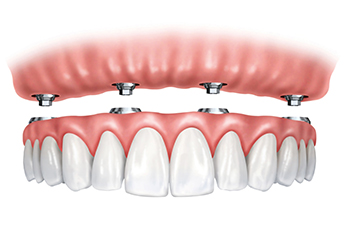Dental Implants: All-on-4, All-on-6, All-on-8
All-on-4, All-on-6 and All-on-8 are “All” (mind the pun) dental implant solutions. They’re each effectively utilized in different situations when someone needs many teeth replaced in either or both of their upper and lower jaws. Here in this article, we’ll discuss the differences between each of these and when they’re recommended, how they work, as well as how to choose the best dental implant option, accordingly.
What are All-on-4, All-on-6 and All-on-8 dental implants?
These “All-on” solutions for tooth replacement each involve a surgical procedure to place implants in the jaw, which will hold the replacement teeth. These procedures are used to reconstruct teeth that were lost from either jaw or both jaws, respectively.
The main idea behind these All-on dental implants is to minimize the number of oral surgeries required. The procedure uses either 4, 6, or 8 implants, onto which a fixed bridge is attached. The construction of the bridge means that there is no need for individual implants for each tooth. No bone augmentation is required. This minimizes the number of surgical sites in the jaw and makes healing faster and easier. The specific distance, angle, and depth required for the implants are carefully determined so that they work correctly in the patient’s mouth.
When are these All-on dental implant solutions recommended?
The All-on-4 treatment, as well as the alternative All-on-6 and All-on-8 options, are effective solutions for people who have lost many adjacent teeth in one jaw, or in the case of complete tooth loss. As a result, patients will regain the full use of their teeth with these permanent dental implants.
What is the difference between All-on-4, All-on-6 and All-on-8 dental implants?
The main difference between these is self-explanatory: four, six, or eight implants are used in the jaw, such that All-On-4 involves the insertion of 4, All-on-6 being that of 6 and All-on-8 for that of 8 implants. The more implants that are used, the stronger and more stable the teeth become, and the more evenly the pressure is distributed to the implants and thus in turn to the jaw itself.
 All of these dental implant options are a good permanent treatment for tooth loss. Which option is utilized will fully depend on the patient’s own individual situation.
All of these dental implant options are a good permanent treatment for tooth loss. Which option is utilized will fully depend on the patient’s own individual situation.
What makes All-on-4, All-on-6 and All-on-8 dental implants a good solution?
All-on implants are used in cases when a patient has lost a lot of teeth. These implants create stable, permanent in effect braces, instead of traditional removable dentures.
The All-on technique has the benefit of usually not requiring bone augmentation, because there are fewer implants to install. The surgical impact is much less than other procedures, generally only requiring one single operation.
Once the implants have been installed, permanent dentures can often be affixed to them after a few days, such that it may even (and thankfully often) be unnecessary to use a removable prosthesis.
These All-on dental implant options all provide stable, firm teeth, which have a natural look and feel.
Replacing full dentition used to in the past require many individual implants, often included jaw transplantation, and took a very long healing time, from 6 to 9 months, before crowns or dentures could be affixed to the implants.
The innovation of the All-on technique leads to a shorter healing time, because using fewer implants, without bone augmentation, translated into a simpler surgery overall. The patient can have temporary dentures installed at the same time as their implants, and the final dentures are generally able to be installed within three months.
Which All-on dental implant option is best?
The decision to use an All-on-4, All-on-6 or All-on-8 solution is highly dependent on the individual patient: which teeth are missing, the condition of the jaw, and other anatomical considerations.
All-on implants naturally integrate into the patient’s jawbone. This means that dental implants can achieve a similar level of stability and strength as natural teeth. The implants in an All-on solution become part of the jaw, and then they function as the base for a bridge that will support the final dentures.
The implants need to have enough bone in the jaw to support them, and the bone needs to be strong. An All-on-8 treatment uses more implants and thus requires more bone with more strength than an All-on-4 treatment.
Jawbone strength is not the only thing that a dentist will consider though. An All-on-4 is the simplest solution and is often successfully used instead of the alternative from the past, which was then undesirably extensive reconstruction of the jawbone. Which teeth are missing and the condition of the remaining teeth is also considered, as well as the general health of the patient.
There is no single best All-on solution. Each patient is assessed individually, so as to best determine whether All-on-4 is appropriate or if another solution will be more in the patient’s interest. In any case, the healing time is greatly reduced and the implants will feel natural, quickly.
Whether All-on-4, All-on-6 or All-on-8 is elected for/with the patient, these type dental implants will help patients who have lost many teeth regain their ability to eat normally and as well recover their beautiful smiles.
What is the dental treatment plan for All-on dental implants?
Consultation and preparation for treatment
The process of preparing for All-on implants begins with a CT scan, which will be utilized during the consultation to help determine whether All-on-4, All-on-6 or All-on-8 treatment will be most beneficial to the patient, and it will also be used to pinpoint the specific placement locations for each implant. The final written dental treatment plan will be created based on this and other information obtained from the patient’s examinations.
Implantation
Once the dental treatment plan is determined, the oral surgery appointment will be scheduled in order to insert the implants, which can be done under varying forms of anesthesia, depending on the place, situation and timing of the procedure.
Four days after the implantation, a bridge will be affixed to the implants, with a temporary prosthesis that allows the patient to quickly be able to eat normally as they’re healing.
Then, about three months after the implantation, when the implants have fully healed and integrated into the jawbone, the temporary teeth will be swapped for a permanent bridge.
The patient will be able to eat, chew heavily, and regain the feel of natural teeth, all within three months with an All-on dental implant procedure.
Regular check-up and oral hygiene
After a successful All-on treatment, it’s important to maintain good oral hygiene habits. The patient will be instructed on proper care, and should have a dental check-up every six months for a thorough cleaning.
And so, whether a patient is best suited with traditional dental implants, or rather with an All-on treatment, is a determination which requires high quality imaging, proper planning and a comprehensive evaluation by a well qualified dentist of your own selection.
In summation, while it may require a bit of investigation, resources and time, happily in the end, most persons who take it upon themselves to arrive at their most favorable dental solution, are usually quite pleased with their final result and marked improvement in tooth function as well as smile.




















